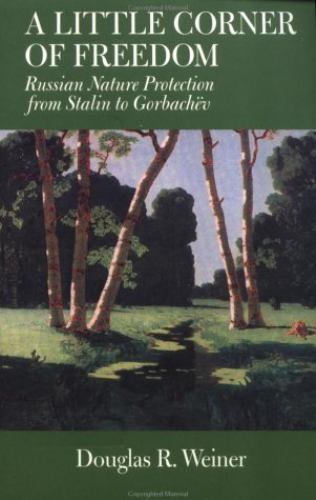Picture 1 of 1

Stock photo

Picture 1 of 1

Stock photo

Little Corner of Freedom : Russian Nature Protection from Stalin to Gorbachev by Douglas R. Weiner (2002, Trade Paperback)

ZUBER (280752)
98.3% positive feedback
Price:
US $51.18
(inclusive of GST)
ApproximatelyS$ 66.30
+ $23.44 shipping
Returns:
30 days return. Buyer pays for return shipping. If you use an eBay shipping label, it will be deducted from your refund amount.
Condition:
Oops! Looks like we're having trouble connecting to our server.
Refresh your browser window to try again.
About this product
Product Identifiers
PublisherUniversity of California Press
ISBN-100520232135
ISBN-139780520232136
eBay Product ID (ePID)1922307
Product Key Features
Number of Pages570 Pages
Publication NameLittle Corner of Freedom : Russian Nature Protection from Stalin to Gorbachev
LanguageEnglish
Publication Year2002
SubjectEnvironmental Science (See Also Chemistry / Environmental), Environmental Conservation & Protection
TypeTextbook
Subject AreaNature, Science
AuthorDouglas R. Weiner
FormatTrade Paperback
Dimensions
Item Height1.7 in
Item Weight32.1 Oz
Item Length9 in
Item Width6 in
Additional Product Features
Intended AudienceScholarly & Professional
LCCN97-040206
Dewey Edition21
TitleLeadingA
IllustratedYes
Dewey Decimal363.7/056/0947
Table Of ContentAcknowledgements Introduction 1. Environmental Activism and Social Identity 2. Archipelago of Freedom 3. The Road to "Liquidation">: Conservation in the Postwar Years 4. Zapovedniki in Peril, 1948-1950 5. Liquidation: The Second Phase, 1950 6. The Deluge, 1951 7. In the Throes of Crisis: VOOP in Stalin's Last Years 8. Death and Purgatory 9. VOOP after Stalin: Survival and Decay 10. Resurrection 11. A Time to Build 12. A Time to Meet 13. More Trouble in Paradise: Crises of Zapovedniki in teh Krushchev Era 14. Student Movements: Catalysts for New Activism 15. Three Men in a Boat: VOOP in the early 1960s 16. Storm over Baikal 17. Science Doesn't Stand Still 18. Environmental Struggles in the Era of Stagnation 19. Enviromental Activism under Gorbachev
SynopsisWhile researching Russia's historical efforts to protect nature, Douglas Weiner unearthed unexpected findings: a trail of documents that raised fundamental questions about the Soviet political system. These surprising documents attested to the unlikely survival of a critical-minded, scientist-led movement through the Stalin years and beyond. It appeared that, within scientific societies, alternative visions of land use, resrouce exploitation, habitat protection, and development were sustained and even publicly advocated. In sharp contrast to known Soviet practices, these scientific societies prided themselves on their traditions of free elections, foreign contacts, and a pre-revolutionary heritage. Weiner portrays nature protection activists not as do-or-die resisters to the system, nor as inoffensive do-gooders. Rather, they took advantage of an unpoliced realm of speech and activity and of the patronage by middle-level Soviet officials to struggle for a softer path to development. In the process, they defended independent social and professional identities in the face of a system that sought to impose official models of behavior, ethics, and identity for all. Written in a lively style, this absorbing story tells for the first time how organized participation in nature protection provided an arena for affirming and perpetuating self-generated social identities in the USSR and preserving a counterculture whose legacy survives today.
LC Classification Number97-40206
All listings for this product
Be the first to write a review












